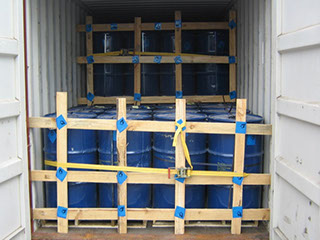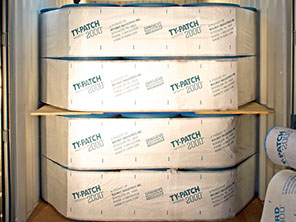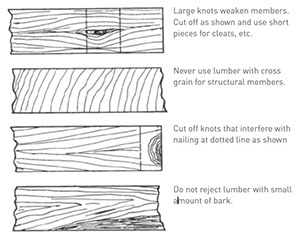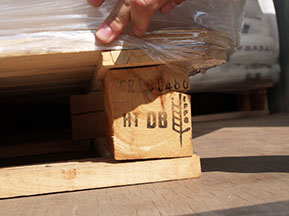CHEMICAL PACKAGING COMMITTEE SHIPPERS GUIDE


DUNNAGE
USE THE CURRENT ASTM STANDARD D996
Basic Function of Dunnage
• Abrasion Protection
• Void Filling
• Package Protection
(such as crushing, denting, or internal damage)
• Load Separation / Segregation
Commonly used material for each function are:
• Wood/Nails used in the construction decking or risers to protect drum rolling hoops and heads from abrasion
• Plywood
• Kraft paper
• Wood overlay with Kraft paper
Criteria for Wood and Nails
Select all blocking and bracing material from sound lumber free from cross grain or dry rot. Do not use lumber with knots, knotholes and check for splits which affect its strength or interfere with proper nailing.
International shipments require compliance with ISPM 15
Void Filling
These structures are used to fill crosswise or lengthwise space in a trailer/container, not occupied by the lading. Void fillers are used to minimize the movement of lading during transportation. Void fillers should be of sufficient height to protect the tallest stack of cargo.
Dunnage Bags
Dunnage bags are usually made of paper, plastic or rubber that are inflated to secure cargo. Filled dunnage bags must not touch floor, as chafing can lead to rupture. Dunnage bags are used to fill voids in a crosswise or lengthwise direction to restrain loads.
Bulkheads
Bulkheads are custom built wood structures used generally to fill voids in a drum load. They are also useful to separate a section of drums in a mixed load. Bulkheads can be faced with plywood to provide a smooth face separator for sections of other type packages.
Fiberboard Fillers
Corrugated or solid fillers come in various shapes and sizes. These types are usually used to prevent side to side motion of the lading. See examples of void fillers below
RESTRAINT SYSTEM COMPONENTS
Restraint systems usually consist of three components:
• the restraint itself (belt, strap, or bulkhead);
• a means of anchoring the restraint to the transport unit; and
• a means of tightening (for belts or straps)
STRAPPING AND WEBBING
Heavy-duty steel strapping has long been the primary choice of unitizing cargos; however, plastic strapping or webbing has seen an increase in use. Strap protectors, such as corner guards or metal plates, should be used to provide a suitable radius to protect straps at all points on lading having sharp edges and/or sharp corners. Be sure tensioning and sealing equipment is used properly. Check the tools periodically to ensure proper operating conditions.
Steel Strapping
Many sizes and strengths of steel strapping are available. In determining which strap is to be used, the shipper must be aware of the weight of each section of the load to be strapped. As a general rule, more straps of lower strength should be used to restrain a load, as opposed to fewer straps of higher strength.
The combined joint strength of the number of straps for rigid braced loads in each longitudinal impact direction must equal the weight of the lading being secured, except as provided in approved loading methods.
Use the proper combination of steel straps, seals, sealing tools, notches or crimps to provide the minimum joint strength for sizes listed in Table 2.H. Figure 2.6 provides examples of notches or crimps.
Restraint
Plastic Strapping
The unique feature of plastic strapping is its ability to stretch under load, then return to its previous tension. Plastic strapping is usually non-woven, taking the form of flat extrusions or adhering strands. The most common width is .” and it is widely available in nylon, polyester, rayon and polypropylene. This makes it superior to steel strapping for compressible packages. In these loads, plastic strapping can retain tension, whereas steel straps may go slack (Note: there may be a loss of tension due to stretching as shown in Figure 2.7). These properties are illustrated in Figure 2.8 and Table 2.J.
Webbing
Webbing is woven to meet various high strength needs; it is available in various materials and weaves. Some typical
polyester specifications may be found in Table 2.K. Nylon webbing has similar values but with 3-4 times higher elongation. Polypropylene in those sizes has about 2/3 the strength of polyester with even higher elongation. For this reason polyester is generally recommended for restraint systems. Joint strength of properly made attachment is normally at least 95% of tensile.
Remember that webbing stretches and may loosen. Webbing must be supported at the gate to prevent falling away from load face.
As this is generally a customized or patented application, it works well. However, in general usage as a system to serve all cargoes, a shipper should beware. Persons using web securing should be trained. All webbing used for this purpose must be rated and carry certification. Most belting systems are color coded for safe working limit. Extreme caution must be taken in regards to chaffing or its use on sharp or uneven surfaces or the webbing will rapidly wear or tear. Also some synthetic fibers will degrade in strong ultraviolet sunlight.
The webbing and fasteners must be carefully checked prior to use to assure they are in good order. And finally, should the system be exposed to extreme heat it will fail far more quickly than steel wire.
This method of bracing is used only in trailers equipped with belt rails attached to the side walls, logistics posts, or in systems using temporary anchoring devices applied to floors that are capable of securing the weight desired. The number, size and strength required under these methods is dependent upon the weight and dimensions of the commodity loaded. The anchored load provides rigid bracing of the lading by the use of steel straps secured to the trailer side walls with load anchors or floor with approved anchor plates.
Apply load anchors per manufacturers’ instructions using correct anchors with appropriate belt rails or logistics posts (see Figure 2.9). Install load anchors a minimum of 18” behind face of load and stagger so no more than two are secured in vertical alignment (see Figure 2.9). Use gates constructed as illustrated in Figures 2.10 and 2.11 with these load anchors. The restraining capacity of two 1 .” x .031” steel straps, which are correctly sealed and anchored on each side wall and correctly tensioned and sealed across the face of the lading, is 7,100 lbs.
When two or more steel straps are used, tension the straps simultaneously to bring the load back uniformly in position and seal the straps (see Figure 2.11). ‘D’ Ring strengths are specified in ISO 1496 Annex F. Bottom rail D rings have 500 Kg maximum capacity and upper D rings have a 1000 Kg maximum capacity. It is very important not to exceed this weight bearing capacity when using D rings as anchor points for your securing systems. One must also take into account G forces when calculating ultimate load
“T” Gates and Beams
“T” Gates - rigid bulkhead designed to fit doorpost slots or vertical brace slots of transport equipment. Not suitable where doorposts are flush with walls.
“T” Gate Beams may be inserted into slotted doorposts at rear of container to restrain packages. Use minimum 2” x 4” lumber, free of knots or other strength impairing defects, of suitable length to fit snugly between doorposts. Use a sufficient number of bulkheads to prevent lading from contacting rear doors. When necessary, use a wooden bulkhead and spacers to fill voids to “T” Gate.
Interior Load Bars
Load Bars are usually made of steel or aluminum. Standard duty bars are designed for economy and ease of use. Heavy-duty bars are designed for maximum restraint. Bars are available in various sizes and some may be equipped with rubber shoes to prevent the bar from slipping.
Rubber Mats
Rubber restraint mats provide a quick and easy method of restraining paper rolls and dense products. Mats eliminate nail damage to floors and have the added benefit of reducing loading and unloading time. Mats are generally reusable, improve safety in loading and are available in pads or perforated rolls.
Ty-Gard
Bonded Fabric load securement is constructed of spun-bonded polyester and polyester yarn with a tensile strength of 600 pounds per inch of width. A 16” wide strip has a load retention value of 9000 pounds. A pressure sensitive adhesive system is used to adhere the laminated webbing to virtually any type side wall.
Other Securement systems
Title 49 Code of Federal Regulations Part 393 describe regulations regarding the use of tie down assembly for U.S.
highway transportation. Although the rules apply to cargo securement in motor vehicles, there are intermodal implications when containerized freight is being transported. Specific rules for tie downs are found in 49CFR section 393.102 of the Federal Motor Carrier Safety regulations

